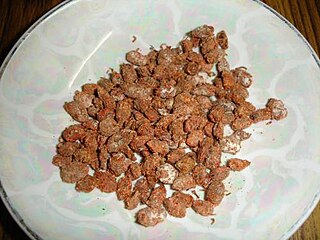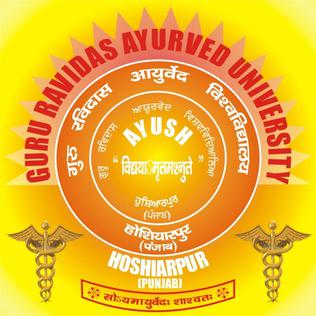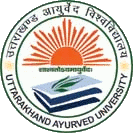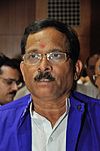
Ayurveda is an alternative medicine system with historical roots in the Indian subcontinent. The theory and practice of Ayurveda is pseudoscientific. The Indian Medical Association describes Ayurvedic practitioners who claim to practice medicine as quacks. Ayurveda is heavily practiced in India and Nepal, where around 80% of the population report using it.

Unani or Yunani medicine is Perso-Arabic traditional medicine as practiced in Muslim culture in South Asia and modern day Central Asia. Unani medicine is pseudoscientific.

Siddha medicine is a traditional medicine originating in South India. It is one of the oldest systems of medicine in India.
The Ministry of Health and Family Welfare is an Indian government ministry charged with health policy in India. It is also responsible for all government programs relating to family planning in India.

The Tamil Nadu Dr. M.G.R. Medical University (TNMGRMU) is a government medical university situated in Guindy in the southern part of the city of Chennai, Tamil Nadu, India. It is about 7 km (4.3 mi) from the Chennai International Airport and about 13 km (8.1 mi) from the Puratchi Thalaivar Dr. M.G. Ramachandran Central Railway Station. It is one of the premier medical universities named after the AIADMK founder and the former chief minister of Tamil Nadu M. G. Ramachandran, endearingly known as M.G.R. and it is the second largest health sciences university in India after Rajiv Gandhi University of Health Sciences, Karnataka.
Bachelor of Ayurvedic Medicine and Surgery (B.A.M.S.) is a degree focused on Ayurveda offered in within India, Nepal, and Bangladesh. and Sri Lanka.

Homeopathy is fairly common in some countries while being uncommon in others. In some countries, there are no specific legal regulations concerning the use of homeopathy, while in others, licenses or degrees in conventional medicine from accredited universities are required.
Dr. Sarvepalli Radhakrishnan Rajasthan Ayurved University, formerly Rajasthan Ayurved University, is Ayurved university in the state Rajasthan. The university situated in Jodhpur was founded on 24 May 2003.

National Institute of Homeopathy (NIH) is an autonomous organisation under the Ministry of Ayurveda, Yoga & Naturopathy, Unani, Siddha and Homeopathy (AYUSH), Government of India. It conducts the BHMS, MD (Homeopathy) and PhD (Homeopathy) courses in Homeopathy. The Institute has a 250-bed hospital, with 10 for surgery and 10 for maternity cases.
Thrissur Ayurveda cluster is an Ayurveda cluster situated in KINFRA Park in Koratty in Thrissur District. The cluster is meant for a comprehensive development of Kerala brand of Ayurvedic products and train the manufacturers of Ayurveda products on the importance of safety, quality and efficacy. The cluster have facilities for testing and analysis, process product validation, safety study and manufacture. The cluster is approved by the Department of Ayurveda, Yoga & Naturopathy, Unani, Siddha and Homoeopathy (AYUSH).

Central Research Institute of Unani Medicine or CRIUM Hyderabad, established in December 1971, is an Indian Government sponsored Unani medicine research center and out patient clinic located in Hyderabad, India. The institute was upgraded to National Research Institute of Unani Medicine for Skin Disorders (NRIUMSD), by Shripad Yesso Naik, Minister of State (IC) for AYUSH in November 2019. The Institute is well known for its successful treatment in skin condition called Vitiligo, perphaps it has treated more than 1.5 lakh patients of Vitiligo alone.
The Journal of Ayurveda and Integrative Medicine is a peer-reviewed open-access medical journal on ayurvedic medicine. It was established in 2010. The editor-in-chief is Bhushan Patwardhan.

Guru Ravidas Ayurved University is a public university for Ayurveda, Yoga & Naturopathy, Unani, Siddha and Homeopathy located in Hoshiarpur, Punjab, India.
National Institute of Unani Medicine (NIUM) is an autonomous organization for research and training in Unani medicine in India. It was established in 1984 at Bangalore under the Department of Ayurveda, Yoga and Naturopathy, Unani, Siddha and Homoeopathy (AYUSH), Ministry of Health and Family Welfare, Govt. of India, in a joint venture with Government of Karnataka.
Vaidya Balendu Prakash is an Indian Ayurveda practitioner. He is a former physician to the President of India and the founder of Paadav, a specialty Ayurvedic hospital in Dehradun. The Government of India awarded him the fourth highest civilian award of the Padma Shri in 1999.
Paneenazhikath Narayana Vasudeva Kurup was an Indian Ayurvedic practitioner, researcher, writer and the founder director of the Central Council for Research in Homoeopathy (CCRIMH). He is a former vice chancellor of the Gujarat Ayurved University, Jamnagar and a former advisor of the Indian Systems of Medicine and Homoeopathy (ISM&H) of the Ministry of Health and Family Welfare. He has published several articles and a book, A Handbook on Indian Medicinal Plants, on the traditional Indian medicine system, The Government of India awarded him the fourth highest civilian honour of the Padma Shri, in 2005, for his contributions to Indian medicine.
North Eastern Institute of Ayurveda & Homoeopathy (NEIAH) is an autonomous institute under the Ministry of AYUSH, within the government of India. It is situated at Mawdiangdiang, Shillong, Meghalaya. It was formally inaugurated by Union Minister of State for Ayush Shripad Yesso Naik on 22 December 2016. Now from session 2019-20 seats have been increased to 63 per year for both the colleges.

Uttarakhand Ayurved University is a state university located at Dehradun, Uttarakhand, India. It was established in 2009 by the Government of Uttarakhand through the Uttarakhand Ayurved University Act, 2009 and focuses on teaching and research of Ayurveda, as well as other areas of AYUSH. Sunil Kumar Joshi was appointed vice chancellor in 2020.
BGR-34 is an Ayurvedic-derived product that is sold in India as an over-the-counter pill for the management of type 2 diabetes. It was developed in 2015 by two government-owned laboratories and launched commercially in 2016. It has been tested in only one, modest-sized, human trial. The drug has been heavily criticized, and without more clinical trials, its efficacy remains unproven. The manufacturers have refused to acknowledge the claims of inefficacy and other concerns.
Dr. B. D. Jatti Homoeopathic Medical College, Hospital and Post Graduate Research Centre is an organization under the Ministry of Ayurveda, Yoga & Naturopathy, Unani, Siddha, and Homeopathy, Government of India. It is affiliated to the Rajiv Gandhi University of Health Sciences, Bengaluru, Karnataka and conducts the graduate degree course in Homeopathy and post-graduate degree courses in Homoeopathy. The college is attached with 60 bedded hospital.










